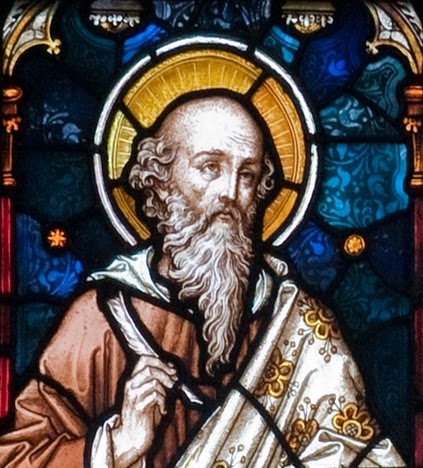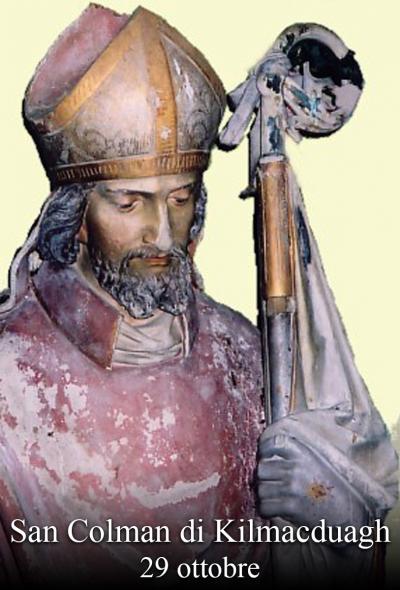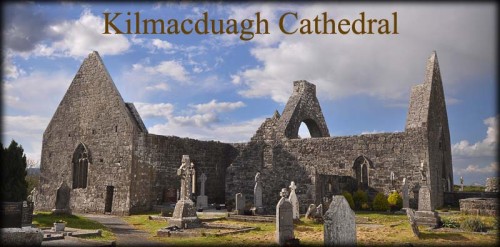Much of the information is taken from
The Project Gutenberg eBook of The Latin & Irish Lives Of Ciaran by R.A. Stewart-Macalister
We also gleaned information from Omni Sanctorum Hiberniae indicated by [… ]
[Ciarán of Clonmacnoise is listed as one of the 12 Apostles of Ireland. He is monastic founder of Clonmacnoise of the sixth century] He was baptised and catechised by deacon Diarmiad, and received formation by St. Finnian, before he was ordained priest at the monastery of St. Enda. [Ciarán went on to establish some monasteries in Ireland, and his Clonmacnoise foundation of great centre for Christian learning in the Celtic world, second only to the famed Iona foundation in Scotland.]
Ciaran of Clonmacnoise was founder of an outstanding influential monastery; the monastic university of Clonmacnoise along the river Shannon, near Athlone. We have much to glean from ‘’The Lives of the Saints’’ which is a series of homilies composed for the festivals of our holy men and women. The aim of the sermons was to edify the congregations by presenting the virtues of their subjects, and, of their thaumaturgic powers. The ‘’Lives of the Saints’’ consists of disconnected anecdotes, describing events that gave occasion for a miraculous display.
The holy abbot St. Ciarán descended from the people of the Latronens, from old kingdom of Midhe, (meath & Westmeath). His father Beonnadus, was a wood worker, making carts for animals to draw forward. Ciarán’s mother Derercha, begat five sons, of whom all were ordained to the presbytery. She had three daughters, two of whom were holy virgins and one became a holy widow. Beonnadus travelled from the coasts of the kingdom of Midhe, into the territories of the Conactha (Connaught. There in the plain of Aei in the stronghold called Raith Crimthain, Beonnadus begot Ciarán. A Wizard of the king Crimthan (Griffen) of Aei, prophesied about the child saying: “The son who is in the womb of the wife of [Beonnadus] shall be [held] in honour before God and before men; as the sun shineth in heaven so shall he himself by his holiness shine in Ireland.” Ciarán was baptized and was reared by his parents in the plains of Aei, and the grace of God was manifest in him.
One day as a very young boy, Ciarán’s mother gave out to him, explaining that the other boys bring honey to their parents every day, from the fields where honey is found, while Ciarán returns with no honey at all. The holy boy Ciarán, went quickly to a spring close by, and filled a vessel with water, then he blessed it, and honey of the best was found in that vessel, which he gave to his mother. The holy deacon Diarmaid upon learning of this, he gave thanks to Christ, and prayed for the boy.
Young Ciarán was a shepherd and often read the Psalms with Diarmaid, though the were a long distance from each other. Ciarán was shepherding in the southern region of Aei, while Diarmaid was teaching from his cell in the northern region of Aei. His words were heard far across the plain, while the boy would read, sitting upon a rock in the field. This same rock is reverenced to day, as the Cross of Christ, that is now placed upon the rock. Their communications from such great distance was a miracle, because no one else heard their discourse, though they could hear themselves clearly.
One day sa small band of thieves came by, and found Ciarán shepherding alone, while reading. The brigands considered to kill him and to plunder his flock. But they were suddenly smitten with blindness, and paralysed, to the point of repentance. They then begged Ciarán to deliver their sight. Ciarán upon seeing their repentant hearts, prayed over them, and their sight returned. The reformed robbers were grateful and proclaimed their story to many.
Another time a pauper came begging for a cow from Ciarán, and begged of him. Ciarán then asked of his mother permission to give a cow to the pauper. But his mother would not have any of it. Ciarán hatched a plan, and on the QT, he gave the pauper a good cow with her calf. But the calf itself was cared for by two cows, so Ciarán gave the pauper the second cow to add to the bargain. The folk seeing Ciarán’s generosity to the poor man, in turn gave Ciarán four cows in alms giving. His mother was scolding him, when Ciarán placated her with the gift of four cows, to which she fell in awe of her son.
One day Ciarán’s father brought home a treasured royal vessel from the court of King Furbithus, for safe keeping. However, Ciarán gave the treasured vessel to a pauper who begged in Christ’s name, as he was destitute. Upon learning of this, the king’s ire was inflamed, and Ciarán would have to serve time for justice’ sake. He was held a slave servant in captivity, at the King’s court. Ciarán’s job was to turn the millstone every day to make flour. But Ciarán was a book worm and would sit by and read, while the millstone, rotated swiftly without human aid to grind corn. For God sent his angels to do the grind work for Ciarán. At around the same time, and by further Divine intervention, a Déise man called Hiernanus of the province of Mumenia (Munster), came to Ciarán and gifted two most excellent vessels, both on a par with the former treasured royal vessel of the king. With the miracle of the millstone and the Déise gifts, the King accepted the ransom and freed Ciarán from servitude. Ciarán then blessed Hiernanus and the Déise tribe for helping him be free again.
As Ciarán grew older, he desired to leave home and go to the school of St. Finnian. Ciarán wished to learn from the Scriptures, with other students there. Ciarán asked his father and mother for the use of a cow to take with him for daily sustenance of milk. His mother was alarmed and denied him, reasoning, “Others who are in that school have no kine.” Not withstanding, Ciarán received the blessing to take leave for the school and the boy set out on his way. Passing by his parent’s cattle, Ciarán blessed a cow, and in Jesus name, he commanded such cow to follow him. The cow duly followed him and her calf followed her. Ciarán and the kine marched to Cluayn Irayrd (Clonard), in the region bordering the Laginenses and Ui Neill.
Ciarán ensured by use of his rod so that the calf would not drink away the store of milk in the cow’s udder. That cow, later called Odar Ciarán, “Ciaran’s Dun” became famous, for the great quantity of milk which could hardly be believed. The large quantity was sufficient for the school. The cow’s hide became venerated in the monastic city of Clonmacnoise; for through it, many miracles were produced. It was so venerated and it was revealed by divine inspiration, that any man who passes away lying upon this hide, shall possess eternal life with Christ.
While at St. finnian’s school, when Ciarán was by himself in his cell, he came to table to take food. He began with a blessing, saying, “Benedicite.” But no one answered “Dominus,” so he got up from the table, without tasting anything that day. He did the same thing the next day, and again no one answered so he rose from the table without food. After fasting for three days, he came to table and prayed, “Benedicite”; and a whispered voice fell from Heaven saying, “The Lord bless thee, weary Ciarán; now is thy prayer matured, since a lone blessing is sufficient to eat. Ciarán gave thanks, ate his bread on the third day.
Ciarán read the gospel of Matthew with Fr. Finnian, in the presence of other students. And coming to the text where is written “All things whatsoever ye would that men should do unto you, so do ye unto them,” Ciarán stopped reading and said to Finnian, “Father, enough for me is this half of this book which I have read;.. verily this one sentence is enough for me to learn.” In this way he was nick named, ‘Leth-Matha’ (Half-Matthew) by the students.” Fr. Finnian added to his new name, as ‘Leth n-Eirenn’ (Half-Ireland). This was a prophecy on the size of his parish, extending through the middle of Ireland.” His school mates were envious of Ciarán over this prophecy.
From St. Finnian’s school, Ciarán went to island of Ara (Inis Mór of the Aran islands), in the west of Ireland. There he rendered service to Abbot Enda. At that time Ciarán saw a marvellous vision of a great and fruitful tree along the river Synna (Shannon) in the middle of Ireland. The tree’s shadow protected Ireland on each side; and its branches flowed into the estuary and beyond. The next day Ciarán related the vision to St. Enda, who forthwith interpreted… paraphrased thus: ”Such fruitful tree witnessed by you, I have also seen too. You are that tree, and you shall be great before God and man. You will be honoured in Ireland, and your shadow of duty and grace shall protect Ireland from demons, plagues, and perils. Your fruit shall be for a profit to many far and wide”. Later Ciarán was consecrated priest and afterwards, at the command of St. Enda, Ciarán returned to the mainland.
[Ciarán lead the life of a perfect priest. He practised the rule of a priest’s life received from his formation at Aran. A contemporary student, St. Carthage, narrated: “the patience, humility, prayer, fast, and (Ciarán’s) cheerful abstinence’’]
One day Ciarán while travelling, he met a pauper along the way. The poor man begged of Ciarán something in alms. The beggar received his only cloak, thus depriving his body of necessary cover. Ciarán journeyed to the island of Cathi (Scattery Island) around the estuary to the Atlantic ocean, at Luimnech (Limerick) between the regions of Kiarraighe and Corco Baiscind. On this island lived St. Senan. While Ciarán approached that Scattery island, Senan sensed interiorly that Ciarán was without comfort in clothing. Senan sent a boat to collect Ciarán, to carry him to the island, with the view of giving Ciarán a new coat in person. It was a welcome act of charity, and Ciarán remained for some days with St. Senan, before he continued his journey.
Ciarán then set out to his visit his brethren Luchenn and Odran, who lived in a cell called Yseal, (the lowest place). Luchenn, the elder, was the abbot, and Odran was prior. One time while there Ciarán was reading in a field on a sunny day, He saw some weary guests entering their guest-house and he went to show hospitality, while forgetting his book, leaving it outdoors, exposed to the elements. His diligence to the weary guest, made him completely forget the book and that night, there was a downpour of rain, but by Divine favour, the opened book remained perfectly dry, even though the ground around was wet. Ciarán and his brethren praised Jesus for the miracle when they found it again.
Ciarán upon departing his brethren, gave a blessing, and taking his books on his shoulders, he went on his way. Ciarán had gone a little distance from the place, when he stumbled upon a gentle stag waiting for him. Ciarán placed his book-satchels on the stag, and followed him. [the stag held his books in it’s antlers while Ciarán read] The stag arrived at Loch Rii (Lough Ree – King’s lake) in east Connaught, and he stopped near Inis Angin, an island in that lake. Ciarán understood by this sign of the stag stopping, that the Lord wanted him to go to that island, and so it happened. The stag went on his merry way.
While at Inis Angin, a community grew. One day it happened that The gospel-book of Ciarán fell into the lake by the careless hand of one of the monks. It was certain that the gospel was lost for good. But one summer’s day, a small number of cows entered the lake looking to refresh themselves from the heat. Afterwards the cows returned to the land, but the binding of a leather book-satchel got tangles in the cow’s hoof, and so the gospel-book inside book-satchel was dragged back to dry land. This gospel-book was found in perfect condition, without dampness nor any moisture. It was well preserved and Ciarán and his followers rejoiced over this miracle.
Later, there came a man called Donnan from the tribe of Corco Baiscind from Mumonia (Munster). He came to Ciarán looking for a place wherein to sojourn, as a servant of Christ. Ciarán permitted Donnan to stay at Inis Angin, as Ciarán felt called to found a new monastery elsewhere. Ciarán left Inis Angin, and settled at Typrait, now called Cluain meic Nois (Clonmacnoise – Meadow of the Sons of Nós). Here Ciarán proclaimed: “Here will I live: for many souls shall go forth in this place to the kingdom of God, and in this place shall be my resurrection.”
The great monastery of Clonmacnoise was founded, and Ciarán’s parish was extensive. Thus St. Finnian’s prophecy and St. Edna’s interpretation of the vision came to pass. The noble river of the Shannon flowed along the verdant plains, and by it’s banks, there was that stately tree laden with leaves and fruits, and covering the land with it’s shade. The monastic site was home to that lush tree with its branches shading Ireland. St. Ciarán as founder became renowned over Ireland. [He became the perfect Abbot.]
At clonmacnois, Ciarán was gifted with an excellent cloak. He was mindful to send it to St. Senan, on the island of Cathi on the Shannon estuary. It was a difficult task to send, as the sea was rough, and the political climate required a lot of pragmatic communications. So from the banks of the Shannon river, at Clonmacnoise, in the centre of Ireland, Ciarán placed the cloak on the river, and it floated along as far as the island of Cathi. The cloak remained dry for the entire duration, arriving safely into the hands of St. Senan who filled with the gift of prophecy sensed its coming. He was filled with thanksgiving as his monks delivered the cloak. It was held in honour, as though it were a sacred diadem.
Ciarán lived only one year at his new monastic site of Clonmacnoise. He recognised his life was slipping away. Now when his final hour approached, Ciarán commanded to be carried outside of the house. He gazed up to heaven, and raising his hand and he blessed his brethren and flock. Ciarán received the Lord’s Sacrifice, and at age thirty three, he gave up his soul. He is buried in Clonmacnoise awaiting his resurrection of his body on the last day. Within the monastic grounds, Kings from the O’Neill tribe were also buried along with St. Ciarán and the monks.
[St. Ciarán died in September in the 540s] He is remember on the 9th September by the Irish Church




 by
by 


